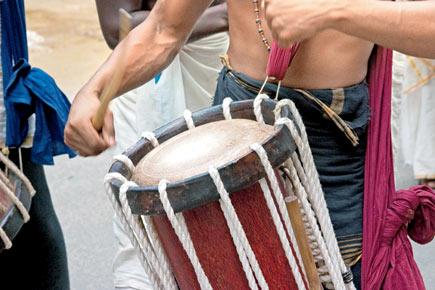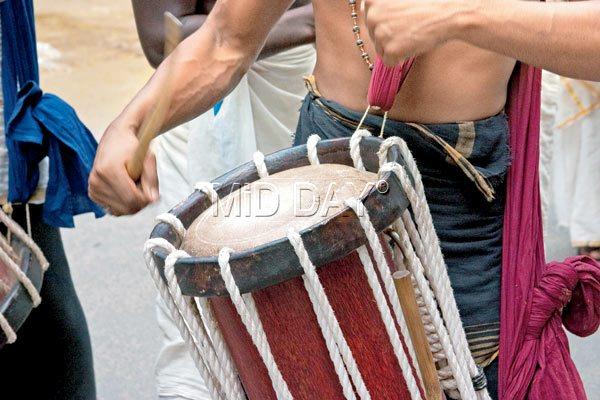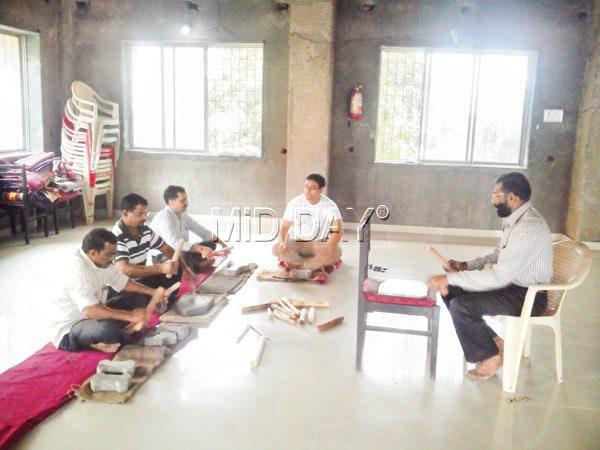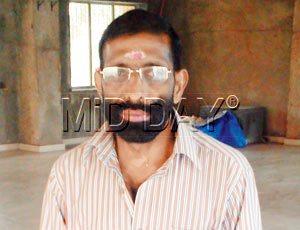Playing a chenda, the traditional drum from Kerala, is no mean feat. Anu Prabhakar meets K Madavankutty, a chenda expert who conducts classes in the city, to learn the intricacies of playing the instrument

At first, we are asked to leave. “There will be no class as there is a private function,” says a man, who seems to be in charge. “Could you please come later?”

ADVERTISEMENT
It is a Sunday morning and we are at the Ayyappa Temple at Kopar Khairane, to meet K Madavankutty, a chenda expert who has been conducting classes within the temple’s premises, and other parts of New Mumbai such as Kharghar and Panvel, for the past 2 months.

The chenda classes. Pics/Anu Prabhakar
We meet him, finally a 58-year-old soft-spoken man from Thrissur, Kerala in the ‘classroom’. We look around, hoping to spot the traditional Kerala drum, when he explains that newbies are allowed to practice on a chenda only 15 days before a programme.

Madavankutty
“Chendas are expensive a normal one costs around Rs 10,000. As they may break, students practice on this,” he says, pointing to a slab of cement and two sticks. Later, he settles down to play a few notes and just like that, transports us from a nondescript room in Mumbai to the dusty, festive grounds of a temple in Kerala.
His beats are fierce and passionate. Madavankutty is oblivious to our admiring looks his eyes are closed, caught in the grip of his own, personal rhythm. He doesn’t stop when 10 students, who are lured by the sound of beats during their ritualistic visit to the temple, peek into the room at regular intervals before joining the impromptu class.
The only time he does look up briefly is when a student discreetly replaces Madavankutty’s slab, now broken into two by the force of his beats.
All about the drum
The chenda is a prominent part of Kerala’s cultural landscape. The wooden drum, which weighs between eight and 10 kg, is played at all important temple festivals and dance performances, such as Kathakali and Theyyam. The two ends of the drum are made out of cow or ox skin.
Traditionally, students are taught using a block of granite and two sticks made from tamarind tree, to help mould students’ hand movements. Stories surrounding the chenda are rather fantastical in nature the instrument’s close association with temples might have something to do with it. For instance, playing the instrument is supposed to ‘wake up’ the gods.
It is also believed that a chenda made from a tree within a temple’s compound will be a superior instrument. Even buying a chenda for yourself is more like a lesson in chemistry and destiny. “You must have a knack to choose a chenda,” points out Madavankutty. “You have to play it, check its ‘swaram’ and then choose,” says the expert, adding that a student must practice playing the chenda for four hours every day, to be a master in the art form.
Keeping tradition alive
After class, we chat with eight-year-old Govindan and his father Venugopal, who works at an IT park in Ghansoli. “I enrolled my son as kids pick up these beats quickly,” says Venugopal, who visits the temple regularly. Madavankutty himself started learning to play the chenda when he was 12-years-old.
However, Govindan and his father are exceptions, for, keeping the art form alive is getting increasingly difficult. “No one follows tradition anymore,” says Madavankutty. “Students are supposed to start classes on an auspicious day. They should have a ‘puja’ with their granite block and sticks.
There is also a certain pose they need to maintain while playing the chenda they should kneel but the posterior should not rest on the back of the legs. Arms must be stretched out while playing the chenda,” says the teacher.
“The guru-shishya relationship has also changed. Ideally, gurus are not supposed to accept a fee,” he adds, looking at his students furtively. “But we need to earn our livelihood. I am determined to keep this art alive and want to leave this world as an artiste,” he smiles.
 Subscribe today by clicking the link and stay updated with the latest news!" Click here!
Subscribe today by clicking the link and stay updated with the latest news!" Click here!







